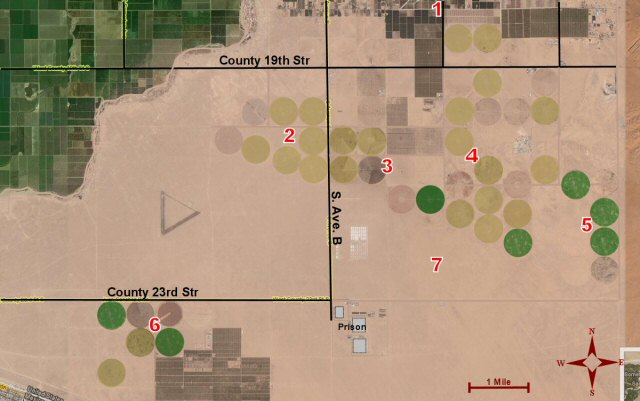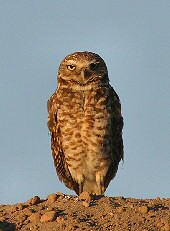Birding Site: South of Yuma Most recent visit: 1 Dec 2007
|
 Ferruginous Hawk |
|
South of Yuma are a variety of agricultural areas ranging from citrus orchards to alfalfa fields. Especially good in the winter months, the area plays host to Prairie Falcon, Ferruginous Hawk, Mountain Plover, Abert's & Green-tailed Towhees, other sparrows, and Lesser & Lawrence's Goldfinches. The desert south of these fields is pretty sparse, but has yielded LeConte's Thrasher. This area is known as the "Yuma Mesa". This desert is beautiful after a wet winter, rich with Ajo Lilly, Birdcage Primrose, and Sand Verbena. If you drive southwest of Yuma, you'll drop down into the Colorado River floodplain. Birds here are similar, with the addition of Ring-necked Pheasant in the wheat fields and a number of riparian birds along the river. |
|
1 |
Orchards and Alfalfa Fields Citrus Orchards, such as the ones here, and especially those with weedy undergrowth, can be good for a number of birds. Accipiters, hawks, woodpeckers, finches, and sparrows are just some of the expected avian delights. Abert’s (resident) and Green-tailed Towhee (winter) are two species to look for. The agricultural fields north of County 19th Street are slowly giving way to housing. But there are still many to be found; these are planted with a variety of crops as the seasons progress. In the past, we have found Prairie Falcon, Ferruginous Hawk, Mountain Plover, curlews, Whimbrel, meadowlarks, and a variety of sparrows in appropriate habitat. |
2 |
Circular Alfalfa & Hay Fields
South of County 19th Street, stretching almost all the way to the Mexican border, are dozens of large (1/2 mile in diameter) circular crop fields. In winter, some of these play host to Prairie Falcon, Ferruginous Hawk, Mountain Plover, Long-billed Curlews, Mountain Bluebird (irruptive species), American Pipit, Horned Lark, and Savannah Sparrow. There is some fine habitat for longspurs, but so far these have proved elusive. There are always fallow fields—sometimes even outnumbering the planted fields; if they’ve been fallow too long the birds move on to more productive areas. Look for birds to perch on top of the sprinklers as well as in the fields themselves. In 2005 we found dozens of Mountain Plover at Site #2, and that spring a Crested Caracara even flew by. In December 2007 a Golden Eagle was feeding on gophers and jackrabbits here. The determining factor in figuring out where the birds are is the food source. The raptors like to feed on the numerous gophers while smaller birds usually like the bugs or seeds available in the fields. If you see water misting (or streaming) down from the big revolving sprinklers, head over to that field and see what birds have come to feed on the resulting insect smorgasbord. |
3 |
Crop Circles The area around here usually has at least one actively planted field. This seems to be one of the better areas for Western Meadowlark. Savannah Sparrows, and Common Ravens. |
4 |
Crop Circles & Cattle Feeding In 2005 and 2006 there were a lot of cattle and the odd herd of sheep in this area. Livestock means more bugs, and more bugs mean more birds. So don’t ignore them! In a field just north of here, a Golden Eagle showed up one morning in January 2006. |
5 |
Crop Circles In 2007 there were several freshly watered crop circles here, including a freshly planted and water field that held Mountain Plover, pipits, and Horned Larks. Mountain Plover can be found in dry grassy fields (similar to their breeding grounds) as well as freshly watered fields--they go where the food is. |
6 |
East of San Luis In 2007 we checked this area just east of San Luis and were happily surprised to find dozens of Ferruginous Hawks, Red-tails, and flocks of Long-billed Curlews. November of 2007 found a Golden Eagle here, too. Be sure to check this area, especially if you don’t have much luck south of Yuma. |
7 |
Deserts In between the crop circles and south of them you’ll see the original desert with scattered creosote, mesquite, sagebrush, and the occasional cactus. Birds are generally sparse and spread thin, but possible here are Burrowing Owls, Loggerhead Shrike, Verdin, LeConte's Thrasher, Phainopepla, and both Sage and Brewer's Sparrow (winter). You might also locate Sage Thrashers here in winter or migration. After a wet winter the wildflower displays can be absolutely spectacular – see some of the photos at www.southwestbirders.com/swb_desert_flowers.htm |
|
Getting south of town from the intersection of I-8 and 16th Street takes less than 10 minutes:
|
|
CommonFerruginous Hawk (w) |
UncommonMerlin (w)
|
RareCrested Caracara
|
|

